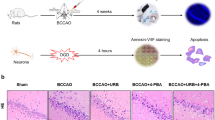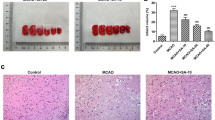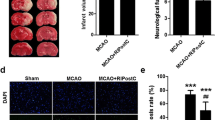Abstract
Parecoxib, a novel COX-2 inhibitor, functions as a neuroprotective agent and rescues neurons from cerebral ischemic reperfusion injury-induced apoptosis. However, the molecular mechanisms underlying parecoxib neuroprotection remain to be elucidated. There is growing evidence that endoplasmic reticulum (ER) stress plays an important role in neuronal death caused by brain ischemia. However, very little is known about the role of parecoxib in mediating pathophysiological reactions to ER stress induced by ischemic reperfusion injury. Therefore, in the present study, we investigated whether delayed administration of parecoxib attenuates brain damage via suppressing ER stress-induced cell death. Adult male Sprague–Dawley rats were administered parecoxib (10 or 30 mg kg−1, IP) or isotonic saline twice a day starting 24 h after middle cerebral artery occlusion (MCAO) for three consecutive days. The expressions of glucose-regulated protein 78 (GRP78) and oxygen-regulated protein 150 (ORP150) and C/EBP-homologous protein (CHOP) and forkhead box protein O 1 (Foxo1) in cytoplasmic and nuclear fraction were determined by Western blotting. The levels of caspase-12 expression were checked by immunohistochemistry analysis, served as a marker for ER stress-induced apoptosis. Parecoxib significantly suppressed cerebral ischemic injury-induced nuclear translocation of CHOP and Foxo1 and attenuated the immunoreactivity of caspase-12 in ischemic penumbra. Furthermore, the protective effect of delayed administration of parecoxib was accompanied by an increased GRP78 and ORP150 expression. Therefore, our study suggested that elevation of GRP78 and ORP150, and suppression of CHOP and Foxo1 nuclear translocation may contribute to parecoxib-mediated neuroprotection during ER stress responses.




Similar content being viewed by others
Abbreviations
- ER:
-
Endoplasmic reticulum
- MCAO:
-
Middle cerebral artery occlusion
- GRP78:
-
Glucose-regulated protein 78
- ORP150:
-
Oxygen-regulated protein 150
- CHOP:
-
C/EBP-homologous protein
- Foxo1:
-
Forkhead box protein O 1
- ATF6:
-
Activating transcription factor 6
- IREI:
-
Inositol-requiring enzyme-I
- PERK:
-
Double-strand RNA-dependent protein kinase (PKR) ER-resident kinase
References
Ferri KF, Kroemer G (2001) Organelle-specific initiation of cell death pathways. Nat Cell Biol 3:E255–E263
Mancini M, Machamer CE, Roy S et al (2000) Caspase-2 islocalized at the golgi complex and cleaves golgin-160 during apoptosis. J Cell Biol 149:603–612
Arduino DM, Esteves AR, Cardoso SM, Oliveira CR (2009) Endoplasmic reticulum and mitochondria interplay mediates apoptotic cell death: relevance to Parkinson’s disease. Neurochem Int 55:341–348
Hayashi T, Saito A, Okuno S, Ferrand-Drake M, Chan PH (2003) Induction of GRP78 by ischemic preconditioning reduces endoplasmic reticulum stress and prevents delayed neuronal cell death. J Cereb Blood Flow Metab 23:949–961
Nakka VP, Gusain A, Raghubir R (2010) Endoplasmic reticulum stress plays critical role in brain damage after cerebral ischemia/reperfusion in rats. Neurotox Res 17:189–202
Ye Z, Wang N, Xia P, Wang E, Yuan Y, Guo Q (2012) Delayed administration of parecoxib, a specific COX-2 inhibitor, attenuated postischemic neuronal apoptosis by phosphorylation Akt and GSK-3β. Neurochem Res 37:321–329
Kudo T, Kanemoto S, Hara H, Morimoto N, Morihara T, Kimura R, Tabira T, Imaizumi K, Takeda M (2007) A molecular chaperone inducer protects neurons from ER stress. Cell Death Differ 15:364–375
Morimoto N, Oida Y, Shimazawa M, Miura M, Kudo T, Imaizumi K (2007) Involvement of endoplasmic reticulum stress after middle cerebral artery occlusion in mice. Neuroscience 147:957–967
Urban P, Pavlíková M, Sivonová M, Kaplán P, Tatarková Z, Kaminska B, Lehotský J (2009) Molecular analysis of endoplasmic reticulum stress response after global forebrain ischemia/reperfusion in rats: effect of neuroprotectant simvastatin. Cell Mol Neurobiol 29:181–192
Sugawara S, Takeda K, Lee A, Dennert G (1993) Suppression of stress protein GRP78 induction in tumor B/C10ME eliminates resistance to cell mediated cytotoxicity. Cancer Res 53:6001–6005
Gomer C, Ferrario A, Rucker N, Wong S, Lee AS (1991) Glucose regulated protein induction and cellular resistance to oxidative stress mediated by porphyrin photosensitization. Cancer Res 51:6574–6579
Jung TW, Lee KT, Lee MW, Ka KH (2012) SIRT1 attenuates palmitate-induced endoplasmic reticulum stress and insulin resistance in HepG2 cells via induction of oxygen-regulated protein 150. Biochem Biophys Res Commun 422:229–232
Matsushita K, Matsuyama T, Nishimura H, Takaoka T, Kuwabara K, Tsukamoto Y, Sugita M, Ogawa S (1998) Marked, sustained expression of a novel 150-kDa oxygen regulated stress protein, in severely ischemic mouse neurons. Mol Brain Res 60:98–106
Takizawa S, Izuhara Y, Kitao Y, Hori O, Ogawa S, Morita Y, Takagi S, de Strihou C, Miyata T (2007) A novel inhibitor of advanced glycation and endoplasmic reticulum stress reduces infarct volume in rat focal cerebral ischemia. Brain Res 1183:124–137
Tajiri S, Oyadomari S, Yano S, Morioka M, Gotoh T, Hamada JI, Ushio Y, Mori M (2004) Ischemia-induced neuronal cell death is mediated by the endoplasmic reticulum stress pathway involving CHOP. Cell Death Differ 11:403–415
Fukunaga K, Ishigami T, Kawano T (2005) Transcriptional regulation of neuronal genes and its effect on neural functions: expression and function of forkhead transcription factors in neurons. J Pharmacol Sci 98:205–211
Liu HJ, Yang JP, Wang CH, Liu RC, Li Y, Li CY (2009) Endoplasmic reticulum in the penumbra following middle cerebral artery occlusion in the rabbit. Neurol Sci 30:227–232
Oida Y, Shimazawa M, Imaizumi K, Hara H (2008) Involvement of endoplasmic reticulum stress in the neuronal death induced by transient forebrain ischemia in gerbil. Neuroscience 151:111–119
Ohoka N, Yoshii S, Hattori T, Onozaki K, Hayashi H (2005) TRB3, a novel ER stress-inducible gene, is induced via ATF4-CHOP pathway and is involved in cell death. EMBO J 24:1243–1255
Wang W, Liu Y, Chen Y, Cao C, Xiang Y, Zhang D, Han L, Zhao H, Liu G (2010) Inhibition of Foxo1 mediates protective effects of ghrelin against lipotoxicity in MIN6 pancreatic beta-cells. Peptides 31:307–314
Leinninger GM, Backus C, Uhler MD, Lentz SI, Feldman EL (2004) Phosphatidylinositol 3-kinase and Akt effectors mediate insulin-like growth factor-I neuroprotection in dorsal root ganglia neurons. FASEB J 18:1544–1546
Nakagawa T, Zhu H, Morishima N (2000) Caspase-12 mediates endoplasmic-reticulum-specific apoptosis and cytotoxicity by amyloid-beta. Nature 403:98–103
Candelario-Jalil E, González-Falcón A, García-Cabrera M, León OS, Fiebich BL (2004) Wide therapeutic time window for nimesulide neuroprotection in a model of transient focal cerebral ischemia in the rat. Brain Res 1007:98–108
Schreiber E, Matthias P, Muller MM, Schaffner W (1989) Rapid detection of octamer binding proteins with “mini-extracts”, prepared from a small number of cells. Nucleic Acids Res 17:6419
Chen L, Gao X (2002) Neuronal apoptosis induced by endoplasmic reticulum stress. Neurochem Res 27:891–898
DeGracia DJ, Montie HL (2004) Cerebral ischemia and the unfolded protein response. J Neurochem 91:1–8
Rao RV, Peel A, Logvinova A, del Rio G, Hermel E, Yokota T (2002) Coupling endoplasmic reticulum stress to the cell death program: role of the ER chaperone GRP78. FEBS Lett 514:122–128
Reddy RK, Mao C, Baumeister P, Austin RC, Kaufman RJ, Lee AS (2003) Endoplasmic reticulum chaperone protein GRP78 protects cells from apoptosis induced by topoisomerase inhibitors: role of ATP binding site in suppression of caspase-7 activation. J Biol Chem 278:20915–20924
Paschen W, Mengesdorf T (2005) Endoplasmic reticulum stress response and neurodegeneration. Cell Calcium 38:409–415
Yuan Y, Guo Q, Ye Z, Pingping X, Wang N, Song Z (2011) Ischemic postconditioning protects brain from ischemia/reperfusion injury by attenuating endoplasmic reticulum stress-induced apoptosis through PI3K-Akt pathway. Brain Res 1367:85–93
Oida Y, Izuta H, Oyagi A, Shimazawa M, Kudo T, Imaizumi K, Hara H (2008) Induction of BiP, an ER-resident protein, prevents the neuronal death induced by transient forebrain ischemia in gerbil. Brain Res 1208:217–224
Lehotský J, Urban P, Pavlíková M, Tatarková Z, Kaminska B, Kaplán P (2009) Molecular mechanisms leading to neuroprotection/ischemic tolerance: effect of preconditioning on the stress reaction of endoplasmic reticulum. Cell Mol Neurobiol 29:917–925
Cechowska-Pasko M, Bańkowski E, Chene P (2005) Glucose effect on the expression of 150 kDa oxygen-regulated protein in HeLa cells. Biochem Biophys Res Commun 337:992–997
Sanson M, Ingueneau C, Vindis C, Thiers JC, Glock Y, Rousseau H, Sawa Y, Bando Y, Mallat Z, Salvayre R, Nègre-Salvayre A (2008) Oxygen-regulated protein-150 prevents calcium homeostasis deregulation and apoptosis induced by oxidized LDL in vascular cells. Cell Death Differ 15:1255–1265
Aleshin AN, Sawa Y, Kitagawa-Sakakida S, Bando Y, Ono M, Memon IA, Tohyama M, Ogawa S, Matsuda H (2005) 150-kDa oxygen-regulated protein attenuates myocardial ischemia-reperfusion injury in rat heart. J Mol Cell Cardiol 38:517–525
Kitano H, Nishimura H, Tachibana H, Yoshikawa H, Matsuyama T (2004) ORP150 ameliorates ischemia/reperfusion injury from middle cerebral artery occlusion in mouse brain. Brain Res 1015:122–128
Osada N, Kosuge Y, Kihara T, Ishige K, Ito Y (2009) Apolipoprotein E-deficient mice are more vulnerable to ER stress after transient forebrain ischemia. Neurochem Int 54:403–409
Li F, Hayashi T, Jin G, Deguchi K, Nagotani S, Nagano I, Shoji M, Chan PH, Abe K (2005) The protective effect of dantrolene on ischemic neuronal cell death is associated with reduced expression of endoplasmic reticulum stress markers. Brain Res 1048:59–68
Yu YQ, Liu LC, Wang FC, Liang Y, Cha DQ, Zhang JJ, Shen YJ, Wang HP, Fang S, Shen YX (2010) Induction profile of MANF/ARMET by cerebral ischemia and its implication for neuron protection. J Cereb Blood Flow Metab 30:79–91
Akhtar S, Yousif MH, Chandrasekhar B, Benter IF (2012) Activation of EGFR/ERBB2 via pathways involving ERK1/2, P38 MAPK, AKT and FOXO enhances recovery of diabetic hearts from ischemia-reperfusion injury. PLoS ONE 7:e39066
Kawano T, Morioka M, Yano S, Hamada J, Ushio Y, Miyamoto E (2002) Decreased Akt activity is associated with activation of forkhead transcription factor after transient forebrain ischemia in gerbil hippocampus. J Cereb Blood Flow Metab 22:926–934
Shioda N, Han F, Moriguchi S, Fukunaga K (2007) Constitutively active calcineurin mediates delayed neuronal death through Fas-ligand expression via activation of NFAT and FKHR transcriptional activities in mouse brain ischemia. J Neurochem 102:1506–1517
Papanicolaou KN, Izumiya Y, Walsh K (2008) Forkhead transcription factors and cardiovascular biology. Circ Res 102:16–31
Aoki M, Jiang H, Vogt PK (2004) Proteasomal degradation of the FoxO1 transcriptional regulator in cells transformed by the P3IK and Akt oncoproteins. Proc Natl Acad Sci 101:13613–13617
Paschen W (2003) Shutdown of translation: lethal or protective? Unfolded protein response versus apoptosis. J Cereb Blood Flow Metab 23:773–779
Mouw G, Zechel JL, Gamboa J (2003) Activation of caspase-12, an endoplasmic reticulum resident caspase, after permanent focal ischemia in rat. Neuro Report 14:183–186
Mouw G, Zechel JL, Zhou Y (2002) Caspase-9 inhibition after focal cerebral ischemia improves outcome following reversible focal ischemia. Metab Brain Dis 17:143–151
Shibata M, Hattori H, Sasaki T (2003) Activation of caspase-12 by endoplasmic reticulum stress induced by transient middle cerebral artery occlusion in mice. Neuroscience 118:491–499
Walter L, Hajnóczky G (2005) Mitochondria and endoplasmic reticulum: the lethal interorganelle cross-talk. J Bioenerg Biomembr 37:191–206
Lei X, Zhang S, Bohrer A, Ramanadham S (2008) Calcium-independent phospholipase A2 (iPLA2 beta)-mediated ceramide generation plays a key role in the cross-talk between the endoplasmic reticulum (ER) and mitochondria during ER stress-induced insulin-secreting cell apoptosis. J Biol Chem 283:34819–34832
Author information
Authors and Affiliations
Corresponding author
Rights and permissions
About this article
Cite this article
Ye, Z., Wang, N., Xia, P. et al. Parecoxib Suppresses CHOP and Foxo1 Nuclear Translocation, but Increases GRP78 Levels in a Rat Model of Focal Ischemia. Neurochem Res 38, 686–693 (2013). https://doi.org/10.1007/s11064-012-0953-4
Received:
Revised:
Accepted:
Published:
Issue Date:
DOI: https://doi.org/10.1007/s11064-012-0953-4




